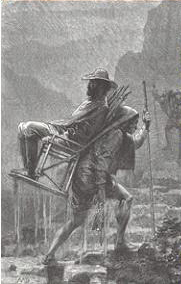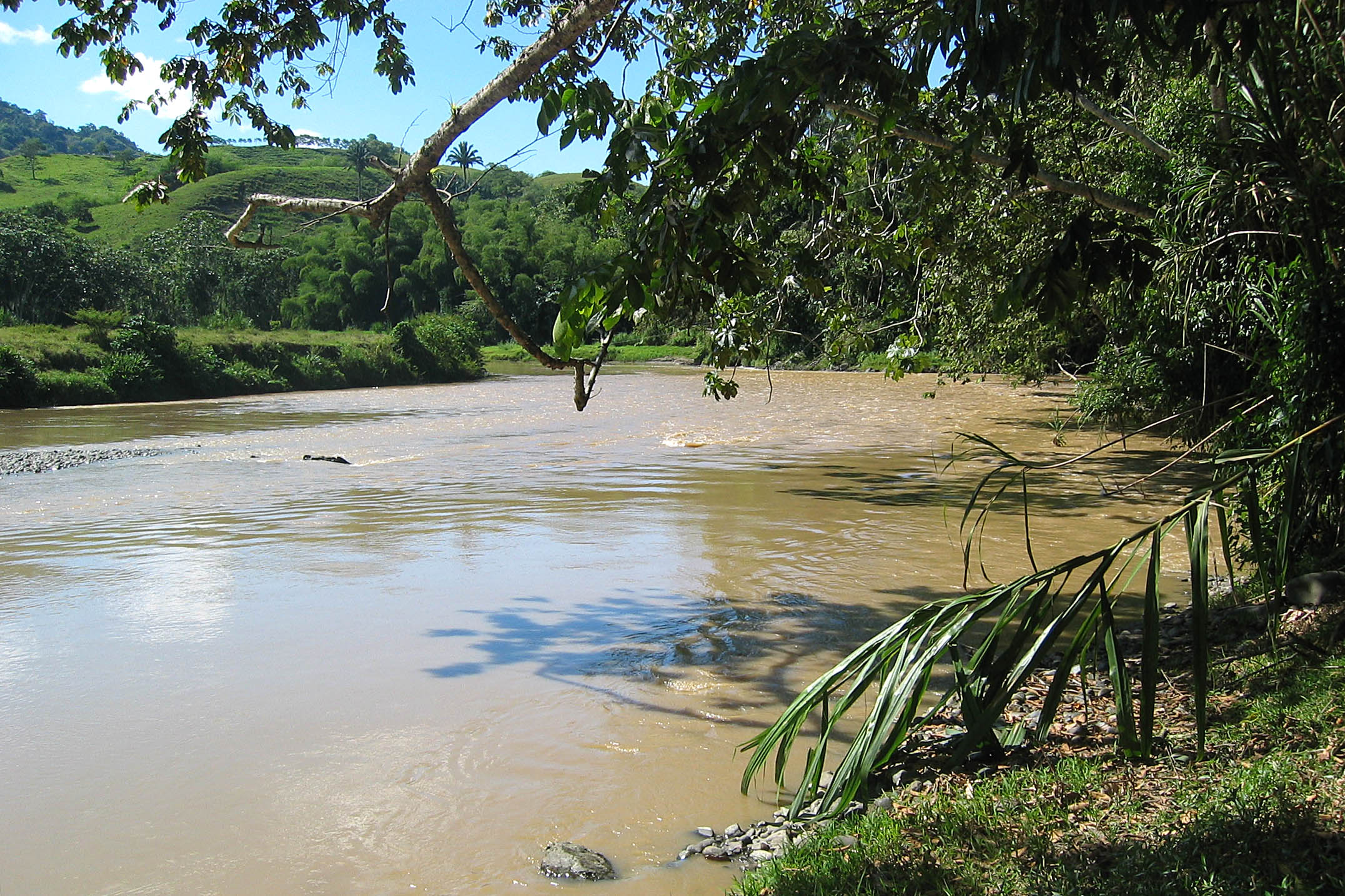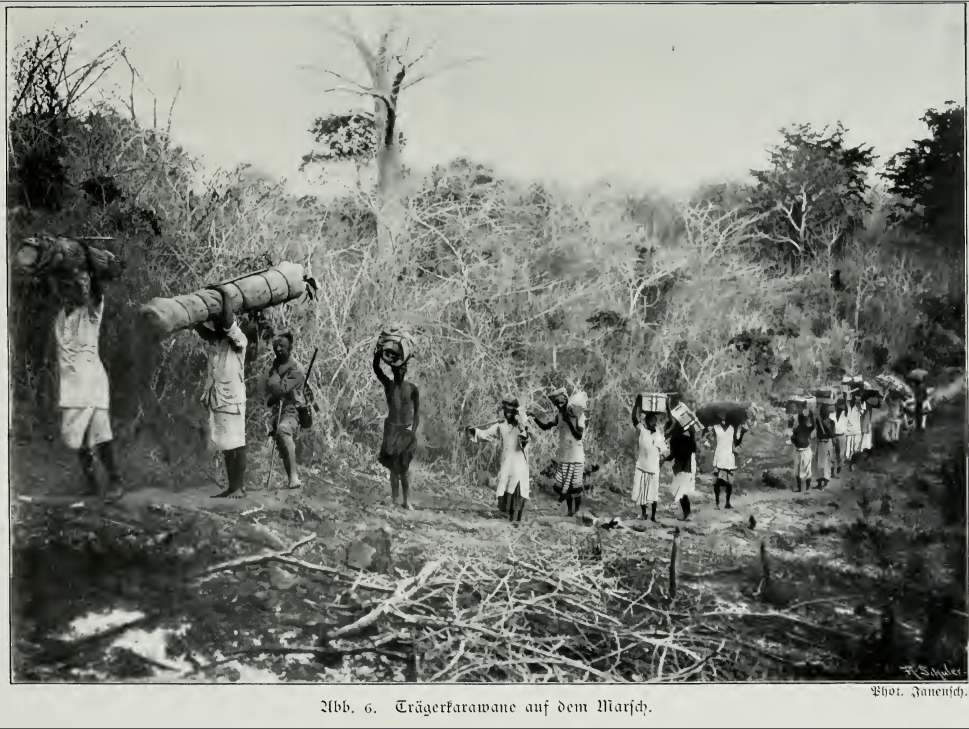|
Sillero
The silleros, cargueros or silleteros (also called saddle-men) were the porters used to carry people and their belongings through routes impossible by horse carriage. A famous example is the use of silleros by colonial officials to be carried across the Quindio pass in the Colombian Andes. History Silleros often carried between of weight crossing the Quindio pass, considered the most difficult of the northern Andean passes. Besides their baggage, silleros even carried the travelers, such as colonial officials or explorers, in a wickerwork chair mounted on their backs. The practice was described by Alexander von Humboldt, who crossed the Quindio in 1801 – he refused to be carried and preferred walking. Humboldt noted that porters were generally mestizo or whites, while others have stated that they were most often Indigenous. The contemporary descriptions often referred to the mode of transportation as ''a lomo de indio'' (on Indian back). Another traveler who described t ... [...More Info...] [...Related Items...] OR: [Wikipedia] [Google] [Baidu] |
Litter (vehicle)
The litter is a class of wheelless vehicles, a type of human-powered transport, for the transport of people. Smaller litters may take the form of open chairs or beds carried by two or more carriers, some being enclosed for protection from the elements. Larger litters, for example those of the Chinese emperors, may resemble small rooms upon a platform borne upon the shoulders of a dozen or more people. To most efficiently carry a litter, porters either place the carrying poles directly upon their shoulders or use a yoke to transfer the load from the carrying poles to the shoulders. Definitions A simple litter consists of a sling attached along its length to poles or stretched inside a frame. The poles or frame are carried by porters in front and behind. Such simple litters are common on battlefields and emergency situations, where terrain prohibits wheeled vehicles from carrying away the dead and wounded. Litters can also be created quickly by the lashing of poles to a chair. ... [...More Info...] [...Related Items...] OR: [Wikipedia] [Google] [Baidu] |
Quindío Department
Quindío () is a department of Colombia. It is in the western central region of the country, crossed by the Andes mountains. Its capital is Armenia. It is famous for the quality of the coffee plantations, colorful architecture, benign weather, variety of hotel accommodations and tourist landmarks. This department is located in a strategic area, in the center of the triangle formed by the three main cities of the country: Bogotá, Medellín and Cali. Quindío is the second-smallest Colombian department (0.2% of the national territory) with 12 municipalities. Ethnographically and culturally, it belongs to the Paisa region. History Before the Spanish invasion the entire area was inhabited by the peoples of the Quimbaya civilization until the 10th century B.C. At the time of Spanish conquest the area was inhabited by indigenous people of Carib descent known as the Pijao tribes. The native population was gradually reduced due to slavery, armed confrontations, and massacres du ... [...More Info...] [...Related Items...] OR: [Wikipedia] [Google] [Baidu] |
Festival Of The Flowers
The Flowers Festival ( es, Feria de las Flores) is a festival that takes place in Medellín, Colombia. The festival is the most important social event for the city and includes a pageant, automobiles, a Paso Fino horse parade and many musical concerts. History The first Flowers Festival took place on May 1, 1957. It was organized by Arturo Uribe, a member of the Board of the Office of Development and Tourism in Medellin, Colombia. The festival lasted for five days with an exposition of flowers displayed in the Metropolitan Cathedral, which was organized by the Gardening Club of Medellín and monsignor Tulio Botero to celebrate the Virgin Mary day. This flower parade represents the end of slavery when slaves carried men and women on their backs up steep hills instead of flowers. The first silleteros parade also took place with some 40 men from the ''corregimiento'' of Santa Elena carrying on their backs flower arrangements to the exposition site. This festival initially took ... [...More Info...] [...Related Items...] OR: [Wikipedia] [Google] [Baidu] |
Medellín
Medellín ( or ), officially the Municipality of Medellín ( es, Municipio de Medellín), is the second-largest city in Colombia, after Bogotá, and the capital of the department of Antioquia. It is located in the Aburrá Valley, a central region of the Andes Mountains in South America. According to the National Administrative Department of Statistics, the city had an estimated population of 2,508,452 according to the 2018 census. With its surrounding area that includes nine other cities, the metropolitan area of Medellín is the second-largest urban agglomeration in Colombia in terms of population and economy, with more than 4 million people. In 1616, the Spaniard Francisco Herrera Campuzano erected a small indigenous village ("''poblado''") known as " Saint Lawrence of Aburrá" (''San Lorenzo de Aburrá''), located in the present-day El Poblado commune. On 2 November 1675, the queen consort Mariana of Austria founded the "Town of Our Lady of Candelaria of Medellín" (''Vil ... [...More Info...] [...Related Items...] OR: [Wikipedia] [Google] [Baidu] |
Porter (carrier)
A porter, also called a bearer, is a person who carries objects or cargo for others. The range of services conducted by porters is extensive, from shuttling luggage aboard a train (a railroad porter) to bearing heavy burdens at altitude in inclement weather on multi-month mountaineering expeditions. They can carry items on their backs (backpack) or on their heads. The word "porter" derives from the Latin ''portare'' (to carry). The use of humans to transport cargo dates to the ancient world, prior to domesticating animals and development of the wheel. Historically it remained prevalent in areas where slavery was permitted, and exists today where modern forms of mechanical conveyance are impractical or impossible, such as in mountainous terrain, or thick jungle or forest cover. Over time slavery diminished and technology advanced, but the role of porter for specialized transporting services remains strong in the 21st century. Examples include bellhops at hotels, redcaps at ... [...More Info...] [...Related Items...] OR: [Wikipedia] [Google] [Baidu] |
Ascent Of Agony
Ascent or The Ascent may refer to: Publications * ''Ascent'' (magazine), an independent, not-for-profit magazine * ''Ascent'' (journal), a literary journal based at Concordia College * ''Ascent'' (novel), by Jed Mercurio * ''Times Ascent'', a weekly supplement of ''The Times of India'' newspaper Film and TV * ''The Ascent'' (1977 film), a Soviet film set in World War II * The Ascent (1994 film), an American war adventure film * '' Kodiyettam'' (''Ascent''), 1977 Indian film written and directed by Adoor Gopalakrishnan * "The Ascent" (''Star Trek: Deep Space Nine''), a 1996 episode of the television series ''Star Trek: Deep Space Nine'' * "Ascent" (''American Crime Story''), an episode of the second season of ''American Crime Story'' * "Ascent" (''Dead Zone''), an episode of ''The Dead Zone'' Music * ''Ascents'' (album), 2000 album by Dennis Bayne Culp * ''The Ascent'' (Wiley album), 2013 album by rapper Wiley * ''The Ascent'' (Secrets album), 2012 debut album by post ha ... [...More Info...] [...Related Items...] OR: [Wikipedia] [Google] [Baidu] |
Michael Taussig
Michael T. Taussig (born 3 April 1940 in Sydney) is an Australian anthropologist and professor at Columbia University. He is best known for his engagement with Karl Marx, Marx's idea of commodity fetishism, especially in terms of the work of Walter Benjamin. Taussig has also published texts on medical anthropology. He was awarded a Guggenheim Fellowship in 1998 and a Berlin Prize in 2007 from the American Academy in Berlin. Early life Taussig was born in Sydney to parents of Germans, German and History of the Jews in the Czech Republic, Czech-Jewish ancestry. He completed his secondary education in 1958 at North Sydney Boys High School. He later earned a medical degree from the University of Sydney as well as a PhD in anthropology at the London School of Economics. ''The Devil and Commodity Fetishism'' (1980) ''The Devil and Commodity Fetishism in South America'' is both a polemic about anthropology and an analysis of a set of seemingly magical beliefs held by rural and urban ... [...More Info...] [...Related Items...] OR: [Wikipedia] [Google] [Baidu] |
Colonial Colombia
Colonial or The Colonial may refer to: * Colonial, of, relating to, or characteristic of a colony or colony (biology) Architecture * American colonial architecture * French Colonial * Spanish Colonial architecture Automobiles * Colonial (1920 automobile), the first American automobile with four-wheel brakes * Colonial (Shaw automobile), a rebranded Shaw sold from 1921 until 1922 * Colonial (1921 automobile), a car from Boston which was sold from 1921 until 1922 Places * The Colonial (Indianapolis, Indiana) * The Colonial (Mansfield, Ohio), a National Register of Historic Places listing in Richland County, Ohio * Ciudad Colonial (Santo Domingo), a historic central neighborhood of Santo Domingo * Colonial Country Club (Memphis), a golf course in Tennessee * Colonial Country Club (Fort Worth), a golf course in Texas ** Fort Worth Invitational or The Colonial, a PGA golf tournament Trains * ''Colonial'' (PRR train), a Pennsylvania Railroad run between Washington, DC and New York C ... [...More Info...] [...Related Items...] OR: [Wikipedia] [Google] [Baidu] |
Sherpa People
The Sherpa are one of the Tibetan ethnic groups native to the most mountainous regions of Nepal, Tingri County in the Tibet Autonomous Region and the Himalayas. The term ''sherpa'' or ''sherwa'' derives from the Sherpa language words ("east") and ("people"), which refer to their geographical origin of eastern Tibet. Most Sherpa people live in the eastern regions of Nepal and Tingri County, though some live farther west in the Rolwaling Valley, Bigu and in the Helambu region north of Kathmandu, Nepal. Sherpas establish gompas where they practice their religious traditions. Tengboche was the first celibate monastery in Solu-Khumbu. Sherpa people also live in Tingri County, Bhutan, and the Indian states of Sikkim and the northern portion of West Bengal, specifically the district of Darjeeling. The Sherpa language belongs to the south branch of the Tibeto-Burman languages, mixed with Eastern Tibet (Khamba) and central Tibetan dialects. However, this language is separate from L ... [...More Info...] [...Related Items...] OR: [Wikipedia] [Google] [Baidu] |
Human-powered Transport
Human-powered transport is the transport of person(s) and/or goods using human muscle power. Unlike animal-powered transport, human-powered transport has existed since time immemorial in the form of walking, running and swimming. Modern technology has allowed machines to enhance human-power. Although motorization has increased speed and load capacity, many forms of human-powered transport remain popular for reasons of cost, convenience, leisure, physical exercise, and environmentalism. Human-powered transport is sometimes the only type available, especially in underdeveloped or inaccessible regions. Modes Non-vehicular *Crawling (human) *Walking (233 watts at 3 mph) ** Walking bus *Running (1,150 watts at 10 mph) * Sprinting (1,690 watts at 15 mph) *Swimming *Climbing and mountaineering *Ice skating, roller skating, and inline skating * Cross-country skiing Human-powered vehicles (HPVs) Land vehicles Skateboards have the advantage of being so small and light tha ... [...More Info...] [...Related Items...] OR: [Wikipedia] [Google] [Baidu] |
Ocosingo
Ocosingo is a city and its surrounding municipality (''municipio'') of the same name in the Mexican state of Chiapas. Overview The northeastern boundary of the municipality is the Usumacinta River, along a portion where the river forms the international border with Guatemala. As of 2010, the municipality had a total population of 198,877, up from 170,280 as of 2005. As of 2010, the city of Ocosingo had a population of 41,878, up from 35,065 as of 2005. Other than the city of Ocosingo, the municipality had 1,387 localities, the largest of which (with 2010 populations in parentheses) were: Nueva Palestina (10,588), Frontera Corozal (5,184), Tenango (4,436), Abasolo (2,884), classified as urban, and Damasco (2,380), Taniperla (2,106), San Quintín (1,732), Cristóbal Colón (1,623), Santo Domingo (1,584), Cintalapa (1,571), Perla de Acapulco (1,527), Santa Elena (1,508), El Censo (1,500), El Sibal (1,472), Nuevo Francisco León (1,420), El Zapotal (1,385), Las Tazas (1, ... [...More Info...] [...Related Items...] OR: [Wikipedia] [Google] [Baidu] |
Palenque
Palenque (; Yucatec Maya language, Yucatec Maya: ), also anciently known in the Itza Language as Lakamhaʼ ("Big Water or Big Waters"), was a Maya city City-state, state in southern Mexico that perished in the 8th century. The Palenque ruins date from ca. 226 BC to ca. 799 AD. After its decline, it was overgrown by the Selva Lacandona, jungle of cedar, mahogany, and sapodilla trees, but has since been excavated and restored. It is located near the Usumacinta River in the Mexican state of Chiapas, about 130 km (81 mi) south of Ciudad del Carmen, above sea level. It averages a humid 26°C (79°F) with roughly of rain a year. Palenque is a medium-sized site, smaller than Tikal, Chichen Itza, or Copán, but it contains some of the finest architecture, sculpture, roof comb and bas-relief carvings that the Maya civilization, Mayas produced. Much of the history of Palenque has been reconstructed from reading the hieroglyphic inscriptions on the many monuments; historians now have a l ... [...More Info...] [...Related Items...] OR: [Wikipedia] [Google] [Baidu] |





